Are you tired of watching your dream vacation slip away because traditional budgeting methods feel like financial imprisonment? Budgeting for holidays doesn’t have to mean eating ramen noodles or becoming a hermit.
Enter the 50-30-20 method – a revolutionary approach that makes saving for your dream getaway feel less like punishment and more like a natural part of your financial flow.
Skale Money Key Takeaways
Before diving deep, here’s what you’ll learn about budgeting for holidays:
- The 50-30-20 method allocates 50% for needs, 30% for wants, and 20% for savings
- You can modify this framework specifically for holiday savings
- Smart automation and digital tools make implementation easier
- You can save for holidays without sacrificing your current lifestyle
- Expect to reach your holiday savings goals in 6-12 months using this method
Expected time investment: 1-2 hours for initial setup, 15-20 minutes weekly for maintenance
Table of Contents
Understanding the 50-30-20 Method Basics
The 50-30-20 budgeting method, popularized by Senator Elizabeth Warren, offers a straightforward approach to managing money. Instead of tracking every penny, this method divides your after-tax income into three main categories.
Let’s break down the traditional split:
- 50% – Essential needs (rent, utilities, groceries)
- 30% – Wants (entertainment, dining out, shopping)
- 20% – Savings (emergency fund, investments, holidays)
Here’s how it looks for different income levels:
| Monthly Income | Needs (50%) | Wants (30%) | Savings (20%) |
| $3,000 | $1,500 | $900 | $600 |
| $5,000 | $2,500 | $1,500 | $1,000 |
| $7,000 | $3,500 | $2,100 | $1,400 |
Adapting the 50-30-20 Rule Specifically for Holiday Savings
When budgeting for holidays becomes a priority, we can temporarily modify the standard percentages. The key is making strategic adjustments without disrupting your essential needs.
Modified breakdown for holiday saving:
- 50% – Keep this for necessities (non-negotiable)
- 25% – Reduced wants
- 25% – Increased savings (with 15% for holidays, 10% for emergency fund)
Table: Holiday-Focused Budget Adjustment
| Category | Regular % | Holiday-Focused % | Monthly ($4000 Income) |
| Needs | 50% | 50% | $2,000 |
| Wants | 30% | 25% | $1,000 |
| Savings | 20% | 25% | $1,000 |
Creating Your Holiday Budget Framework
Start by establishing a clear framework for your holiday savings journey. This foundation will guide your entire budgeting process.
Essential steps:
- Calculate your total monthly after-tax income
- List all monthly expenses
- Set a specific holiday savings target
- Determine your timeline
Holiday Budget Planning Template:
| Expense Category | Current Amount | Potential Savings |
| Housing | $___ | $___ |
| Transportation | $___ | $___ |
| Food | $___ | $___ |
| Entertainment | $___ | $___ |
Smart Strategies for the 50% Necessities Portion
Managing your necessities efficiently creates more room for holiday savings. Focus on optimizing these essential expenses without compromising quality of life.
Key areas to optimize:
- Housing costs: Consider a roommate or negotiate rent
- Utility bills: Implement energy-saving measures
- Groceries: Meal planning and bulk buying
- Transportation: Explore cheaper alternatives
Cost-Cutting Examples:
| Category | Current Cost | Optimized Cost | Monthly Savings |
| Utilities | $200 | $150 | $50 |
| Groceries | $500 | $400 | $100 |
| Transport | $300 | $200 | $100 |
Maximizing the 30% Wants Category Without Feeling Deprived
The key to successful budgeting for holidays lies in smart management of your “wants” spending. Focus on value-based decisions rather than deprivation.
Strategic approaches:
- Replace expensive habits with cheaper alternatives
- Use the “24-hour rule” for non-essential purchases
- Find free or low-cost entertainment options
- Practice mindful spending
Alternative Activities:
- Host potluck dinners instead of eating out
- Use streaming services instead of cinema
- Exercise outdoors instead of gym membership
- Join free community events
Supercharging Your 20% Holiday Savings
Transform your holiday savings from a dream to reality with strategic saving approaches.
Practical strategies:
- Set up automatic transfers on payday
- Use high-yield savings accounts
- Maximize credit card reward points
- Consider seasonal side hustles
Savings Growth Timeline:
| Month | Regular Savings | With Side Hustle | Total |
| 3 | $1,800 | $600 | $2,400 |
| 6 | $3,600 | $1,200 | $4,800 |
| 12 | $7,200 | $2,400 | $9,600 |
Digital Tools and Apps for 50-30-20 Management
Leverage technology to automate your holiday savings journey.
Recommended tools:
- Budgeting apps (Mint, YNAB)
- Savings apps (Qapital, Digit)
- Travel booking platforms (Hopper, Kayak)
- Price tracking tools (Camelcamelcamel)
Common Pitfalls and How to Avoid Them
Understanding common challenges helps prevent derailment of your holiday savings plan.
Key issues to watch:
- Impulse spending triggers
- Emergency expenses
- Seasonal spending pressures
- Social pressure
Solutions:
- Keep an emergency fund separate from holiday savings
- Use the envelope method for discretionary spending
- Find an accountability partner
- Track progress visually
Real Success Stories and Case Studies
Sarah and Tom’s Story: “Using the 50-30-20 method, we saved $5,000 for our dream vacation to Japan in just 8 months. The key was automating our savings and finding creative ways to reduce our ‘wants’ spending without feeling deprived.”
Key success factors:
- Consistent automation
- Clear goal setting
- Regular progress tracking
- Flexibility in approach
Conclusion
Budgeting for holidays doesn’t mean sacrificing your current lifestyle. The 50-30-20 method provides a flexible framework that adapts to your needs while keeping your vacation dreams alive. Start small, stay consistent, and watch your holiday fund grow.
FAQ
How long does it take to save enough using this method?
With disciplined use of the 50-30-20 method, most people can save for a moderate holiday in 6-12 months.
Can I modify the percentages based on my income?
Yes, the percentages are guidelines and can be adjusted based on your specific situation and goals.
What if I have irregular income?
Use your average monthly income as a baseline and adjust percentages during higher-earning months.
How do I handle unexpected expenses?
Maintain a separate emergency fund alongside your holiday savings to avoid dipping into vacation money.
Is this method suitable for all types of holidays?
Yes, the method can be scaled up or down depending on your holiday budget target.
How do I stay motivated during the savings period?
Set mini-goals, visualize your destination, and celebrate small wins along the way.
Remember, successful budgeting for holidays is about finding a sustainable approach that works for your lifestyle. The 50-30-20 method offers the flexibility and structure needed to make your travel dreams a reality without sacrificing your daily joy.
Want to get started? Download our free budget template and join our community of successful holiday savers. Your dream vacation is closer than you think!
![]()




